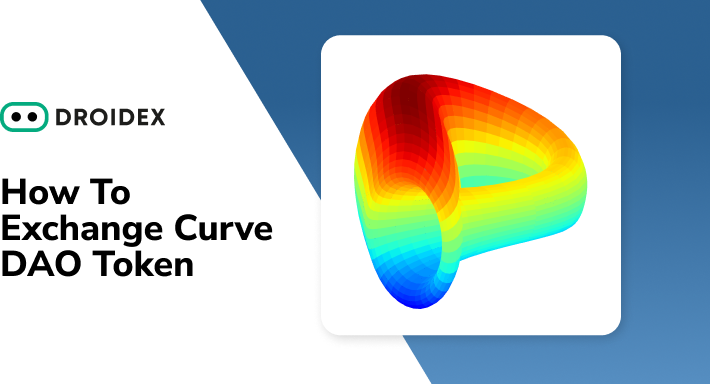Decentralized finance (DeFi) – capacity-building sector that uses smart contracts to swap tokens – attracts the attention of more and more digital asset owners with each passing day. Today’s article will tell you about one of the crypto market players, Curve DAO Token (CRV), which allows you to enjoy all the benefits of DeFi, offering both its platform and native token for exchange through DEXs and DeFi services aggregators. What is a CRV, how it works, where it’s better to exchange a token, etc. – all the necessary info can be found right here. Let’s get to it!
What is a CRV?
Curve DAO (CRV) token is an Ethereum token that provides an automated market maker, as well as a decentralized exchange and the Curve.fi protocol. The protocol is designed to facilitate the exchange between ERC-20-like tokens, including stablecoins and Ethereum-based Bitcoin tokens.
Classified under CoinDesk’s Digital Asset Classification Standard (DACS) as an Application token, Curve DAO is an original asset of a decentralized exchange that trades cryptocurrencies without the need for an intermediary, (DeFi) Curve.
Being one of the world’s largest decentralized financing platforms, it offers opportunities to buy, or earn a CRV token, through profit-making. This is how you can receive tokens as a reward by investing DAI assets in the Curve liquidity pool, in addition to commissions and interest.
How CRV works
The creation of the CRV was aimed at attracting liquidity to the platform and encouraging users to participate in management processes, including voting on important decisions and future protocol changes.
Launched in August 2020, the CRV immediately peaked at $6.93, but then dropped to $0.33 in October. In 2021, due to industry growth, CRV regained its former value, and floated for some time until this month’s recent breakout.
At AMM like Curve, liquidity pools are tailored to “high sales” and “cheap purchases”.
Take, for example, the dollar-bound USD Coin (USDC) and the DAI. To restore the DAI to USDC ratio after adding DAI surpluses to the pool, DAI is sold at a small discount compared to USDC. Otherwise, the pool will remain unbalanced as DAI becomes larger than USDC.
During DAI sales at a reduced price, the pool tries to restore its previous state. In terms of price, Curve’s assets are stable relative to each other and, while trading, users create minimal volatility compared to other similar platforms, where pools are running around any of the tokens traded.
Thus, Curve limits the type of asset in the pool, eliminating cost losses due to volatility in the liquidity pool relative to the market value of the token. Although such volatile losses create not only risks for users, but also profit opportunities (you only need to enter and exit the pool at the optimal time) instead of creating conditions for high risk (and therefore rewards) with volatility AMM Curve chooses its value DeFi layout. This approach involves creating an ecosystem around the platform to reward the investment in it from other related sources.
The values invested in different assets in the Curve case will not always remain equal or proportional to each other. Thanks to this imbalance, Curve can direct liquidity to generate attractive prices for assets in one price category. In this way, Curve can make the most of liquidity with complicated mathematics behind the curtains of this project to serve the simple, obvious, and pure mission most elegantly.
Curve liquidity pools are also formed around token versions of Bitcoin, which are characterized by their instability. This does not endanger the mission of the platform, as the Curve method does not require stability: the corresponding tokens in the pools must be stable only relative to each other. It is very sophisticated in terms of design and requires maneuver. This method requires the selection of functional combinations (for example, wBTC and renBTC in contrast to wBTC and USDC). Not surprisingly, under such computational and technical conditions, Curve needed an Ethereum-based token to provide automated pairing exchange of similar ERC-20 tokens between users. Well, recently, it has been considered one of the best DeFi tools to invest in.
How to exchange CRV?
How to exchange CRV? We recommend you have a look at our smart Droidex aggregator. Droidex is convenient, quick and safe, and has the best rates. That’s why we consider it a good suggestion to those who want to swap tokens profitably.
- Visit droidex.io and click “Start Swap”.
- Choose the Ethereum blockchain, if you want to swap CRV tokens.
- Select tokens – for example, CRV and USDT.
- Enter the number of tokens – let it be 100. Then, press “Connect Wallet”.
- Connect the wallet – for instance, MetaMask.
- Tap “Swap”.
- Click “Confirm Swap”.
- That’s it! Get your tokens!
Conclusion
Even if some of the information about Curve’s approach might sound tricky, there are no-doubt deliverables about its impact on the DeFi development:
- Curve is based on AMM (automated market maker) for exchanging tokens at a similar price: these are stable dollar-pegged coins, such as USDC, USDT, DAI. Also, thanks to Curve, you can exchange BTC-linked tokens, such as sBTC, RenBTC, and WBTC, for the best prices.
- Unlike other AMMs, Curve prefers layout stability instead of uncontrolled variability and sustainable development instead of quick speculation tips. The platform is highly trusted by users in the DeFi environment and serves as a capstone to an ecosystem led by a CRV token. All this makes Curve a model of a decentralized organization that truly belongs to its users and values DeFi.
- For beginners, this makes Curve with its tokens a suitable and reliable provider in the cryptocurrency exchange market.
- Those who are up to swap tokens with good rates can always use decentralized exchanges and DeFi services aggregators – for instance, Droidex.


